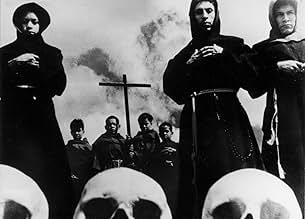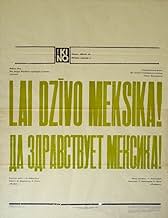IMDb रेटिंग
7.4/10
2 हज़ार
आपकी रेटिंग
अपनी भाषा में प्लॉट जोड़ेंEisenstein shows us Mexico in this movie, its history and its culture. He believes, that Mexico can become a modern state.Eisenstein shows us Mexico in this movie, its history and its culture. He believes, that Mexico can become a modern state.Eisenstein shows us Mexico in this movie, its history and its culture. He believes, that Mexico can become a modern state.
- निर्देशक
- लेखक
- स्टार
- पुरस्कार
- कुल 1 जीत
फ़ीचर्ड समीक्षाएं
This is the greatest documentary fiction I've ever seen, despite this movie was incomplete the beauty of the images is great, with a great culture you can make magic with the camera. The Mexican people have a wonderful big culture and personally I didn't know a little things about my own country.
About the part of fiction is great that this reality is happening know and the sense of revolution is present, i think that only a Russian could understand the sense of the work people.
The drama and the courage of the indians in the defense of the honor and the repression is a symbol of the revolution that needs the country.
About the part of fiction is great that this reality is happening know and the sense of revolution is present, i think that only a Russian could understand the sense of the work people.
The drama and the courage of the indians in the defense of the honor and the repression is a symbol of the revolution that needs the country.
Que Viva Mexico is an interesting (reconstruction of a) film by Sergei Eisenstein, the director of so many masterpieces. In fact, of all that I have seen, this is the only non-masterpiece of the bunch. Even the reconstruction of Beshin Meadow I like more. Que Viva Mexico is a semi-documentary. Most of it is uninteresting and, unlike Eisenstein's other films and Tisse's other cinematography, poorly composed. The only parts of real interest come near the end, with the rebellion, something that Eisenstein was used to creating on screen. There is a great gunfight with a woman participating, a precursor to Alexander Nevsky's Vasilisa, and there is a great scene where some rebels are buried up to the shoulders underground and then trampled by horses (by far the best scene in the film). The Day of the Dead celebration is also very interesting. There is also a bullfight that will demonstrate just how cruel bullfighting is.
I do have to complain about the reconstruction that I watched. This was supposed to be a silent film, I believe. The narration I did not mind, for Eisenstein would have had to find a way to communicate what the narrator did anyway. And the music is good, often great. But I object to the insertion of diagetic sound effects, like guns shooting and horses galloping. This is ridiculous. Obviously the only people who are ever going to see this film are Eisenstein enthusiasts, so to try to sell it to the public as a sound movie is ridiculous. Why?
I do have to complain about the reconstruction that I watched. This was supposed to be a silent film, I believe. The narration I did not mind, for Eisenstein would have had to find a way to communicate what the narrator did anyway. And the music is good, often great. But I object to the insertion of diagetic sound effects, like guns shooting and horses galloping. This is ridiculous. Obviously the only people who are ever going to see this film are Eisenstein enthusiasts, so to try to sell it to the public as a sound movie is ridiculous. Why?
It's unbelievable how everything can be art when you look through the eyes of a genius. Sergei Eisenstein: the master of editing, the great father of Russian cinema, a role model for other famous directors like Charlie Chaplin or Andrei Tarkovski; author of cinematic masterpieces like Battleship Potemkin, Ivan the Terrible and Alexander Nevsky. Now we have his version of his Mexican adventure: "Que Viva Mexico!" an epic semi-documentary lost in time. Why was it lost in time for decades? Because no one in Russia or in the USA trusted this film enough to show it. Eisenstein was a nobody when he arrived in the USA to plan another project, the soviet authorities didn't want him in the USSR due to his polemic point of views of the October Revolution and the czarism. Sergei adored Mexico because of its beauty and its hospitality. Famous Mexican painters like Diego Rivera, Frida Kahlo and David Alfaro Siqueiros, along with his Russian partner Trotsky, helped him to inspire. Eisenstein filmed his version of the Mexican traditions and he was very close. As a Mexican, I didn't realized how magical these traditions were until I watched this film. A really good film maker knows how to show the real life in a fantastic way. Now, do I have to say the name of this really good film maker? I don't think so, I think you already know. "Que Viva Mexico!" highly recommendable, Mexican fellows: watch it, this is your real country.
Film buffs know the history of this lost all too well- Eisenstein came to Hollywood to work for Paramount, Paramount and Sergei never really saw eye to eye. Before giving up on making an American Production, Upton Sinclair invited Eisenstein to make a feature film about Mexico. Eisenstein shot miles of footage, and the money and interest from backers ran out. Eisenstein was forced to return to his native Russia without his Mexican footage. The footage was cut together by others at about this time to make THUNDER OVER MEXICO, and they did not follow Eisenstein's editing notes (They simply made an edit every four seconds. Watch the film and count, you'll see what I mean...) This version, completed by his associates 30 years after his 1948 death comes close to Eisenstein's intent, but without Eisensetin at the editing board, something is missing.
This resulting video is entralling. His incredible shot compositions (which influence me to no end as a film-maker) are all there. There's one scene, which involves a shoot-out reminds us what a John Wayne western directed by Eisenstein would of lookied like.
This resulting video is entralling. His incredible shot compositions (which influence me to no end as a film-maker) are all there. There's one scene, which involves a shoot-out reminds us what a John Wayne western directed by Eisenstein would of lookied like.
Sergei Eisenstein's relationship with Hollywood was naturally doomed from the outset but a light appeared at the end of the tunnel when he was given the opportunity by Upton and Mary Sinclair of making a film in Mexico about that country's history and culture and contracted to deliver the finished product in six months. When he arrived in Tetlapayec he declared: "This is the place I have been looking for all my life!" Predictably his artistic vision kicked in and his ideas for the film became more grandiose. Like most great creative artistes Eisenstein felt constrained by neither time nor money but eventually both ran out. The plug was pulled, he was summoned back to Russia and lost control of editing thousands of feet of film. It was not until long after his death that his script advisor at the time, Grigori Alexandrov, was able to piece together what we now know as 'Que Viva Mexico!"
Although fragmented, enough remains to make this an engrossing and emotional experience. Contrasted with the lyricism of a courtship and marriage we have the brutal images of a bull's carcass being dragged from the ring and the trampling to death of the peons. It is to be regretted that nothing at all was filmed of what promised to be the most exciting episode, that of the Mexican Revolution. What little remains of the Epilogue is a filmic gem. How blessed was Eisenstein in having the services of cinematographer Edward Tissé.
We should be grateful I suppose to have this much considering the fate that befell his 'Bezhin Meadow'.
Eisenstein was a director of monumental stature but destined to be sorely tried. This Mexican misadventure must surely have been a bitter disappointment to him but his biographer Marie Seton has observed that as a result of this failed project "an entirely new filmic theory of composition came to him." Looking ahead to 'Alexander Nevsky' and 'Ivan the Terrible', she may very well be right.
Although fragmented, enough remains to make this an engrossing and emotional experience. Contrasted with the lyricism of a courtship and marriage we have the brutal images of a bull's carcass being dragged from the ring and the trampling to death of the peons. It is to be regretted that nothing at all was filmed of what promised to be the most exciting episode, that of the Mexican Revolution. What little remains of the Epilogue is a filmic gem. How blessed was Eisenstein in having the services of cinematographer Edward Tissé.
We should be grateful I suppose to have this much considering the fate that befell his 'Bezhin Meadow'.
Eisenstein was a director of monumental stature but destined to be sorely tried. This Mexican misadventure must surely have been a bitter disappointment to him but his biographer Marie Seton has observed that as a result of this failed project "an entirely new filmic theory of composition came to him." Looking ahead to 'Alexander Nevsky' and 'Ivan the Terrible', she may very well be right.
क्या आपको पता है
- ट्रिवियाItalian censorship visa # 75561 delivered on 25 September 1980.
- गूफ़The rifles Sebastian and his friends take from the gallery are of lever-action design, in the following gun-fight in the cactus fields they unmistakably use single-shot bolt-action rifles.
- कनेक्शनEdited from ¡Que viva Mexico! (1932)
टॉप पसंद
रेटिंग देने के लिए साइन-इन करें और वैयक्तिकृत सुझावों के लिए वॉचलिस्ट करें
- How long is Que Viva Mexico?Alexa द्वारा संचालित
विवरण
- चलने की अवधि1 घंटा 30 मिनट
- रंग
- ध्वनि मिश्रण
- पक्ष अनुपात
- 1.37 : 1
इस पेज में योगदान दें
किसी बदलाव का सुझाव दें या अनुपलब्ध कॉन्टेंट जोड़ें

टॉप गैप
By what name was ¡Que viva México! Da zdravstvuyet Meksika! (1979) officially released in India in English?
जवाब




















